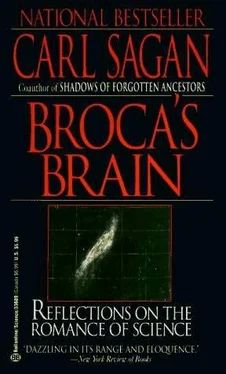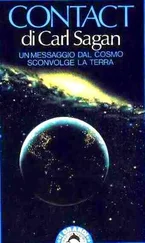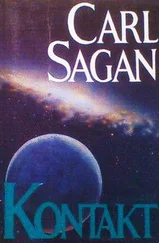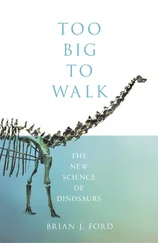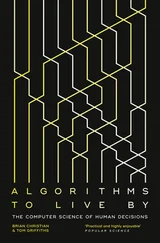Carl Sagan - Broca's Brain - The Romance of Science
Здесь есть возможность читать онлайн «Carl Sagan - Broca's Brain - The Romance of Science» весь текст электронной книги совершенно бесплатно (целиком полную версию без сокращений). В некоторых случаях можно слушать аудио, скачать через торрент в формате fb2 и присутствует краткое содержание. Жанр: Физика, на английском языке. Описание произведения, (предисловие) а так же отзывы посетителей доступны на портале библиотеки ЛибКат.
- Название:Broca's Brain: The Romance of Science
- Автор:
- Жанр:
- Год:неизвестен
- ISBN:нет данных
- Рейтинг книги:3 / 5. Голосов: 1
-
Избранное:Добавить в избранное
- Отзывы:
-
Ваша оценка:
- 60
- 1
- 2
- 3
- 4
- 5
Broca's Brain: The Romance of Science: краткое содержание, описание и аннотация
Предлагаем к чтению аннотацию, описание, краткое содержание или предисловие (зависит от того, что написал сам автор книги «Broca's Brain: The Romance of Science»). Если вы не нашли необходимую информацию о книге — напишите в комментариях, мы постараемся отыскать её.
Broca's Brain: The Romance of Science — читать онлайн бесплатно полную книгу (весь текст) целиком
Ниже представлен текст книги, разбитый по страницам. Система сохранения места последней прочитанной страницы, позволяет с удобством читать онлайн бесплатно книгу «Broca's Brain: The Romance of Science», без необходимости каждый раз заново искать на чём Вы остановились. Поставьте закладку, и сможете в любой момент перейти на страницу, на которой закончили чтение.
Интервал:
Закладка:
We appear to be on the verge of developing a wide variety of intelligent machines capable of performing tasks too dangerous, too expensive, too onerous or too boring for human beings. The development of such machines is, in my mind, one of the few legitimate “spinoffs” of the space program. The efficient exploitation of energy in agriculture-upon which our survival as a species depends-may even be contingent on the development of such machines. The main obstacle seems to be a very human problem, the quiet feeling that comes stealthily and unbidden, and argues that there is something threatening or “inhuman” about machines performing certain tasks as well as or better than human beings; or a sense of loathing for creatures made of silicon and germanium rather than proteins and nucleic acids. But in many respects our survival as a species depends on our transcending such primitive chauvinisms. In part, our adjustment to intelligent machines is a matter of acclimatization. There are already cardiac pacemakers that can sense the beat of the human heart; only when there is the slightest hint of fibrillation does the pacemaker stimulate the heart. This is a mild but very useful sort of machine intelligence. I cannot imagine the wearer of this device resenting its intelligence. I think in a relatively short period of time there will be a very similar sort of acceptance for much more intelligent and sophisticated machines. There is nothing inhuman about an intelligent machine; it is indeed an expression of those superb intellectual capabilities that only human beings, of all the creatures on our planet, now possess.
CHAPTER 21

What has been done is little-scarcely a beginning; yet it is much in comparison with the total blank of a century past. And our knowledge will, we are easily persuaded, appear in turn the merest ignorance to those who come after us. Yet it is not to be despised, since by it we reach up groping to touch the hem of the garment of the Most High.
AGNES M. CLERKE,
A Popular History of Astronomy
(London, Adam and Charles Black, 1893)
THE WORLD has changed since 1899, but there are few fields which have changed more-in the development of fundamental insights and in the discovery of new phenomena-than astronomy. Here are a few titles of recent papers published in the scientific magazines The Astrophysical Journal and Icarus: “G240-72: A New Magnetic White Dwarf with Unusual Polarization,” “Relativistic Stellar Stability: Preferred Frame Effects,” “Detection of Interstellar Methylamine,” “A New List of 52 Degenerate Stars,” “The Age of Alpha Centauri,” “Do OB Runaways Have Collapsed Companions?,” “Finite Nuclear-size Effects on Neutrino-pair Bremsstrahlung in Neutron Stars,” “Gravitational Radiation from Stellar Collapse,” “A Search for a Cosmological Component of the Soft X-ray Background in the Direction of M31,” “The Photochemistry of Hydrocarbons in the Atmosphere of Titan,” “The Content of Uranium, Thorium and Potassium in the Rocks of Venus as Measured by Venera 8,” “HCN Radio Emission from Comet Kohoutek,” “A Radar Brightness and Altitude Image of a Portion of Venus” and “A Mariner 9 Photographic Atlas of the Moons of Mars.” Our astronomical ancestors would have extracted a glimmer of meaning from these titles, but I think their principal reaction would have been one of incredulity.
WHEN I WAS ASKED to chair the 75th Anniversary Committee of the American Astronomical Society in 1974, I thought it would provide a pleasant opportunity to acquaint myself with the state of our subject at the end of the past century. I was interested to see where we had been, where we are today, and if possible, something of where we may be going. In 1897 the Yerkes Observatory, then the largest telescope in the world, was given a formal dedication, and a scientific meeting of astronomers and astrophysicists was held in connection with the ceremony. A second meeting was held at the Harvard College Observatory in 1898 and a third at the Yerkes Observatory in 1899, by which time what is now the American Astronomical Society had been officially founded.
The astronomy of 1897 to 1899 seems to have been vigorous, combative, dominated by a few strong personalities and aided by remarkably short publication times. The average time between submission and publication for papers in the Astrophysical Journal (Ap. J.) in this period seems to be better than in Astrophysical Journal Letters today. The fact that a great many papers were from the Yerkes Observatory, where the journal was edited, may have had something to do with this. The opening of the Yerkes Observatory at Williams Bay, Wisconsin-which has the year 1895 imprinted upon it-was delayed more than a year because of the collapse of the floor, which narrowly missed killing the astronomer E. E. Barnard. The accident is mentioned in Ap. J. (6:149), but one finds no hint of negligence there. However, the British journal Observatory (20:393), clearly implies careless construction and a cover-up to shield those responsible. We also discover on the same page of Observatory that the dedication ceremonies were postponed for some weeks to accommodate the travel schedule of Mr. Yerkes, the robber-baron donor. The Astrophysical Journal says that “the dedication ceremonies were necessarily postponed from October 1, 1897,” but does not say why.
Ap. J. was edited by George Ellery Hale, the director of the Yerkes Observatory, and by James E. Keeler, who in 1898 became the director of the Lick Observatory on Mount Hamilton in California. However, there was a certain domination of Ap. J. by Williams Bay, perhaps because the Lick Observatory dominated the Publications of the Astronomical Society of the Pacific (PASP) in the same period. Volume 5 of the Astrophysical Journal has no fewer than thirteen plates of the Yerkes Observatory, including one of the powerhouse. The first fifty pages of Volume 6 have a dozen more plates of the Yerkes Observatory. The Eastern dominance of the American Astronomical Society is also reflected by the fact that the first president of the Astronomical and Astrophysical Society of America was Simon Newcomb, of the Naval Observatory in Washington, and the first vice presidents, Young and Hale. West Coast astronomers complained about the difficulties in traveling to the third conference of astronomers and astrophysicists at Yerkes and seem to have voiced some pleasure that promised demonstrations with the Yerkes 40-inch refractor for this ceremony had to be postponed because of cloudy weather. This was about the most in the way of interobservatory rancor that can be found in either journal.
But in the same period Observatory had a keen nose for American astronomical gossip. From Observatory we find that there was a “civil war” at the Lick Observatory and a “scandal” associated with Edward Holden (the director before Keeler), who is said to have permitted rats in the drinking water at Mount Hamilton. It also published a story about a test chemical explosion scheduled to go off in the San Francisco Bay Area and to be monitored by a seismic device on Mount Hamilton. At the appointed moment, no staff member could see any sign of needle deflection except for Holden, who promptly dispatched a messenger down the mountain to alert the world to the great sensitivity of the Lick seismometer. But soon up the mountain came another messenger with the news that the test had been postponed. A much faster messenger was then dispatched to overtake the first and an embarrassment to the Lick Observatory was, Observatory notes, narrowly averted.
Читать дальшеИнтервал:
Закладка:
Похожие книги на «Broca's Brain: The Romance of Science»
Представляем Вашему вниманию похожие книги на «Broca's Brain: The Romance of Science» списком для выбора. Мы отобрали схожую по названию и смыслу литературу в надежде предоставить читателям больше вариантов отыскать новые, интересные, ещё непрочитанные произведения.
Обсуждение, отзывы о книге «Broca's Brain: The Romance of Science» и просто собственные мнения читателей. Оставьте ваши комментарии, напишите, что Вы думаете о произведении, его смысле или главных героях. Укажите что конкретно понравилось, а что нет, и почему Вы так считаете.
